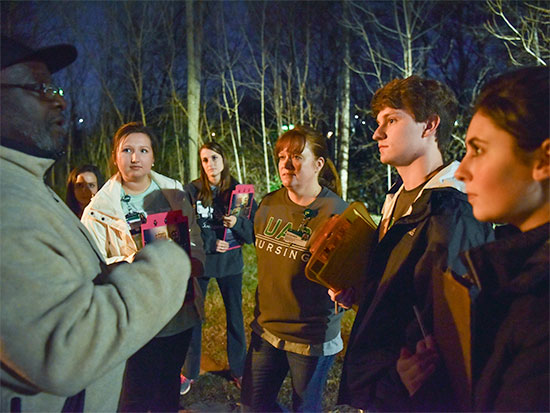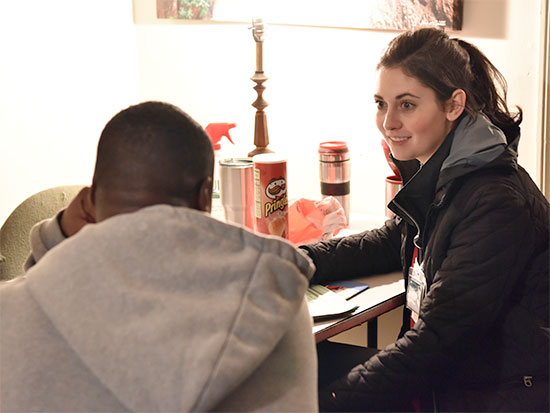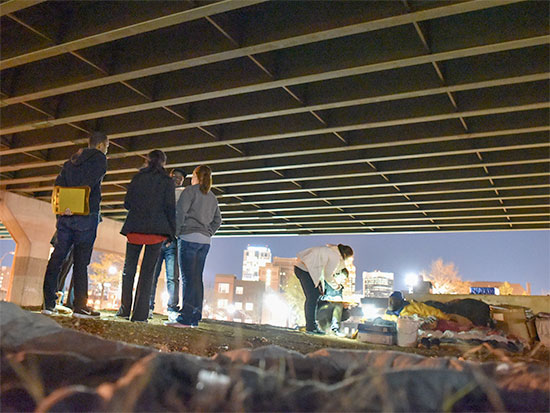Media contact: Adam Pope, arpope@uab.edu
 UAB Nursing students worked with Melvin Harris from the Firehouse Shelter to understand more about homelessness.For University of Alabama at Birmingham School of Nursing students in the Concepts of Community and Public Health Nursing class, the reality of homelessness was driven home as they participated in the Point in Time homeless community mini-census.
UAB Nursing students worked with Melvin Harris from the Firehouse Shelter to understand more about homelessness.For University of Alabama at Birmingham School of Nursing students in the Concepts of Community and Public Health Nursing class, the reality of homelessness was driven home as they participated in the Point in Time homeless community mini-census.
Point in Time is an annual canvass of the metro Birmingham area to gather valuable information about the homeless community in central Alabama, and is vital for understanding demographics, tracking trends, identifying gaps in community services and planning future work in the fight to end homelessness.
It depends on community volunteers, such as School of Nursing Assistant Professor Sallie Shipman, R.N., and her students, who in conjunction with experienced street outreach workers affiliated with the One Roof organization, ventured out across the city to find and focus on homeless individuals.
In the shadows, with the bright lights of the Birmingham skyline as a backdrop, and the whiz of cars and trucks on the roadway above, students learned lessons about an underserved population that are hard to come by in a classroom.
For this latest Point in Time census, conducted on a chilly late-January evening, the students’ guide was Melvin Harris, an employee of the Firehouse Shelter, a men’s homeless shelter that runs programs and offers affordable housing at 16 locations across Birmingham. Harris is a true veteran of the streets, having been homeless himself for eight years in the late 1980s and early 1990s.
He knows Birmingham’s backstreets and alleyways because he has lived on them, and because he now regularly takes to them trying to provide the same help he received. He knows of some from his homeless period who are still on the streets.
“I was homeless with a lot of people,” Harris said. “Some of them are still out here for whatever reason, and I want to help them like I was helped. God has blessed me to get my life back together again, and I have been able to grow spiritually, mentally and physically. I’ve got a new family, a wife and son. I am very blessed.
 Christen Cline asks a shelter resident survey questions to compile information on homeless individuals in the Birmingham area for the Point in Time census.“Now God is allowing me to give back, and I am very proud to be able to show the students where these people live and who they are.”
Christen Cline asks a shelter resident survey questions to compile information on homeless individuals in the Birmingham area for the Point in Time census.“Now God is allowing me to give back, and I am very proud to be able to show the students where these people live and who they are.”
Following Harris’ lead, Shipman and the students took a well-beaten path beneath the overpass to a large hole cut into a chain-link fence. Passing through that, they entered a world of litter and debris.
On their first stop, a homeless man who identified as a veteran agreed to participate as long as he did not have to stand up to do so. As two students squatted to speak with him, the man answered the first few questions then drifted off into a discussion about current events and politics. After much circling back, the students were able to complete his survey.
Then they moved a few hundred yards north and approached a blue pup tent. After appearing tentative to respond to Harris at first, the young woman inside soon seemed to warm to the conversation and the companionship.
She has long suffered from anxiety and extreme claustrophobia, which particularly manifests itself when she tries to live indoors. She has had difficulty maintaining interpersonal relationships and at times has had to leave different shelters after becoming aggravated with other residents.
“It makes you realize that you’re only one paycheck away from being homeless yourself,” said Harris, who watched as the young woman accepted an offer of bottled water and snacks. “You lose your job, lose your finances, lose your way; you could be homeless just like that with nowhere else to turn.”
Yet standing there in the midst of despair, Harris was filled with hope for the future. It is hope based on ideas and actions, and the next generation of leaders like the UAB School of Nursing students.
“We’ve got these young people with their fresh minds who are open to new ideas and not afraid to take chances,” Harris said. “They’re willing to go into the underbrush, under the bridges and overpasses, things like that to try to help.
“It lets me know that we have got a chance of life getting a whole lot better on these streets and in our community.”
 As part of the annual Point in Time census of the Birmingham homeless community, Sallie Shipman, R.N., left, and students from the School's NUR429L Concepts of Community and Public Health Nursing class speak with a young woman they met living in a tent under one of the city's overpasses.The student group went on to visit two shelter homes, one all-male and one all-female, giving them well-rounded insight into the numerous avenues of help available to homeless individuals in the area.
As part of the annual Point in Time census of the Birmingham homeless community, Sallie Shipman, R.N., left, and students from the School's NUR429L Concepts of Community and Public Health Nursing class speak with a young woman they met living in a tent under one of the city's overpasses.The student group went on to visit two shelter homes, one all-male and one all-female, giving them well-rounded insight into the numerous avenues of help available to homeless individuals in the area.
At each stop, the students enthusiastically asked the survey questions. In turn, many of the interviewees were noticeably excited someone had stopped to talk with and learn more about them.
One Roof community outreach coordinator Courtney Stinson says the few minutes each student spent with a homeless individual were of immeasurable benefit to One Roof in its efforts to unite central Alabama to end homelessness.
“Point in Time gives us a snapshot of what our homeless community looks like on any given night,” Stinson said. “Our partnership with the UAB School of Nursing is especially important because nursing students will go on to serve this very population as professional nurses. Getting that one-on-one interaction and getting to see some of the real issues impacting the homeless community are important to their career development, and it helps us tremendously.
“By participating in Point in Time, they get to see what life is like on the streets and, we hope, realize that homelessness is not a condition but an experience someone is having.”
Teaching one of the courses that puts into practice the school’s mantra of “think globally, act locally,” Shipman is opening the eyes and shaping the minds of her students.
“The way it changes their perceptions, their ideas and, in many cases, their entire approach to the health care profession truly has to be seen to be believed,” Shipman said.
Shipman recalls a story of one her early students in the class who was assigned to work at the Firehouse Shelter.
“She was actually upset at me for putting her there because she wanted to work in maternal-child,” Shipman said. “At midterm she told me ‘Dr. Shipman, I was really mad at you for putting me here at first, but I realize now this is where I needed to be.’ Just that quickly, she realized how different it is with the homeless population and how much impact she could have as a nurse working with that population. It was very satisfying to see.”
“You can tell someone what’s going on, but it’s a whole lot better when you can bring them out and let them see it for themselves,” Harris said. “These people they met on the streets and under the bridges are the same ones who will come into the hospitals and the clinics when they move on to their careers. When they do come in, these students will understand them much better.”